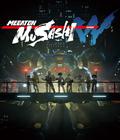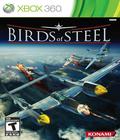This console generation has seen a good number of flight combat games. From the antiquated stuff of Red Baron to the slightly futuristic fare of Tom Clancy's H.A.W.X. 2, a good deal of them are arcade flight games, where technical details give way to white-knuckle aerial action. The flight simulation game remains the domain of the PC and its myriad of flight sticks and pedals, though we have seen a few attempts to port this to the console world in the form of IL-2 Sturmovik: Birds of Prey and Apache: Air Assault, both titles courtesy of Gaijin Entertainment. Not content with its offerings thus far, the Russian development house has returned to the World War II setting with Birds of Steel, a flight game that pleases both camps, even if it leans toward the simulation side.
The first thing you'll notice is how the difficulty levels dramatically change things when you play. There are three difficulty levels as well as a separate option for toggling limited ammo and fuel counts. Simple gives you gameplay similar to an arcade-style flight game, where your primary concern is flying without getting shot or crashing. Realistic adds physics, so you'll be limited in the tricks you can pull off if you don't know how to pilot your plane. Experiencing blackouts, having the plane stall from a steep climb, and manipulating the controls more to escape from a dive are just a few of your concerns at this difficulty level. Then there's Simulation, which throws in everything that the Realistic setting does but takes away the minimal HUD elements, such as radar and the altimeter reading. It forces you to read the instrumentation in the cockpit or rely on your instincts to pilot the crafts, and it makes for a much more harrowing experience.
As expected, the different difficulty levels use of every button and button combination available on your control pad. Even in Simple, you'll use combinations of the d-pad and right analog stick to look around your environment. The game does a good job of letting you adjust the sensitivity of the sticks and button placement to give you the most comfortable setting, but the game also supports a number of the flight sticks for your preferred console.
The game wants the player to experience things at either the Realistic or Simulation setting. Though casual players can enjoy everything the game offers, they'll travel at a normal plane speed instead of a more accelerated one, and that can provide lengthy lulls in the action since targets are usually spread apart. There may be less to worry about control-wise when tailing an enemy plane, but shooting it down isn't entirely point-and-click. Even though most of the plane's operations are automatic and you start some missions airborne, you still have to master takeoffs and landings, which can get perilous on the small platforms of an aircraft carrier. These little things add up to an experience that favors a plodding, calculated experience rather than one with a quicker pace.
To that end, Birds of Steel does a good job of making you pay attention to details. The slightest alteration in speed might not matter to more casual players, but to simulation fans, it could throw off the approach in a landing or mean a better angle needs to be reached to pull up from a dive. Consequently, the slightest angle change makes a world of difference when landing or trying to get the jump on enemy planes. The game excels at these little things, and it'll please simulation fans who miss seeing it on consoles.
The title offers quite a few modes. The main campaign mode focuses on the first two years of the Pacific Theatre of air combat from the Pearl Harbor invasion to the battle of Guadalcanal. After a lengthy four-part tutorial that teaches you the basics of air and sea combat as well as takeoffs and landings, you'll be able to select the American or Japanese campaign missions. As expected, the missions overlap, so even though you'll be fighting the same battles twice, you'll go through different objectives and experience different reactions from non-airborne forces depending on the chosen side.
Interestingly enough, while campaign mode does a good job of mixing up objectives (bombing and torpedo runs, regular dogfights, etc.), it doesn't put too much effort into telling you a story. You always play the role of a random pilot with no name or backstory, and the cut scenes, while narrated well by Stephen Fry, are simply cuts of old World War II newsreels with some background on the battles. It isn't a necessarily bad approach, but those who have played console games backed by The History Channel will recognize the campaign's approach and focus more on the event than telling a narrative through the roughly 20 available missions.
Luckily for gamers, the title offers more than just the campaign. There are a variety of single missions that extend beyond the sorties offered in the campaign. They include the European and Mediterranean Theatres of air combat and offer the usual assortment of combat, bombing, and escort missions. Dynamic missions only take place in eight specific battles, but they give you the chance to change your objectives between rounds, similar to the way multiplayer matches are handled in other games. The territories and ground and sea forces expand or retreat depending on your performance for that round, giving you more incentive to perform well. The game also gives you the opportunity to create custom missions with just about any parameter. The player has a near-limitless assortment of things to do in the game for quite a long time.
It is here that Birds of Steel really shows off its breadth by letting you choose from over 100 planes. Regular fighters and bombers from the major players in the war are represented, but some of the more obscure stuff, such as the Australian Beaufighter Mk 21 and the Italian MC 202, are also present. While these planes can't be customized in terms of performance tweaks, they can be augmented cosmetically with new noses, kill decals and paint jobs, so those who want to re-create something like the famed Memphis Belle can do so easily with the tools provided. This large library of items remains locked away when you start up the game, and it is only unlocked through a combination of player leveling via in-game experience and earning credits to purchase said items. Leveling and money earning isn't easy, however, and those who stick with the single-player experiences will find themselves grinding through mission after mission with little payout. The bigger rewards come through in multiplayer online play, which contributes to your overall profile pool.
With the exception of the main campaign, all of the other modes support online play in addition to a territorial, team-based versus mode. Both competitive and cooperative modes are supported for up to 16 players, and all difficulty levels are supported right off the bat. In addition to this, the developers have tournaments where players can compete in a set map with set rules for a limited amount of time to see who is top dog. It makes the multiplayer portion just as extensive as the single-player campaign. The online play is lag-free except for those few situations where players with bad connections try to jump into matches with others halfway around the world. More importantly, there's already a small but healthy community rallying around the game.
For the most part, the audio delivers. The effects are excellent and provide a good replacement for a formal soundtrack. The rush of the wind, constant gunfire, and loud roar of the engine blast through your speakers but are more impressive when you go from an exterior view into a cockpit view and notice that the sounds change to become more muffled. The score is comprised mostly of orchestral pieces that give the game a classic war movie feel, and even though it dominates the menus, it segues into the game's standard combat noise. The voices are fine but not that exciting. They do well enough in providing mission info and tutorial lessons, but the incidental radio chatter repeats far too often and has the tendency to show up when it shouldn't. Additionally, the voices are sometimes overpowered by the music and sound effects. Generally, though, you'll want to have the sound turned up when you're playing this title.
Like the sound, the graphics do a good job in making Birds of Steel look appealing. Each plane sports an amazing amount of detail, though it becomes more evident when you take in the cockpit view. The instrument panels look great, but looking to the side reveals details like bolts on the metal and scratches on the glass. The environments show vehicles moving about, and buildings and trees are actual structures instead of textured flat images, like they are in other games. The lighting is notable, as it provides a shimmer to the ocean and casts some faint shadows on the planes; it also blinds you when you're facing the sun and trying to look at your instrument panel. There are a few places where things aren't quite as polished. Sometimes, shadows on the ground suddenly appear, and the ocean looks like mercury when you get close to it and see that it moves in a rhythmic pattern. Everything else about the graphics is impressive.
Birds of Steel is a title that casual fans will enjoy, but it has more appeal to airplane aficionados of that particular era. The plethora of available planes and the attention to detail really showcases the development team's dedication. The presentation is excellent, despite a few flaws, and the game is a meaty experience on the single-player side despite the apparent focus on online multiplayer options. It may not be perfect, but this is one of the best airplane simulators on a console yet.
Score: 8.0/10
More articles about Birds Of Steel











 Birds of Steel is a breath-taking combat simulator featuring some of the most pivotal air battles of World War II, including the battle of Midway, Guadalcanal, Coral Sea, the historic attack on Pearl Harbour, the Mediterranean Maltese island, Germany’s Ruhr Valley, and others.
Birds of Steel is a breath-taking combat simulator featuring some of the most pivotal air battles of World War II, including the battle of Midway, Guadalcanal, Coral Sea, the historic attack on Pearl Harbour, the Mediterranean Maltese island, Germany’s Ruhr Valley, and others.

















































